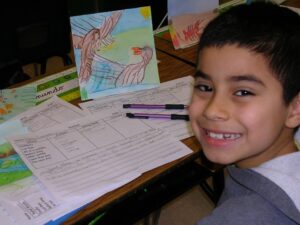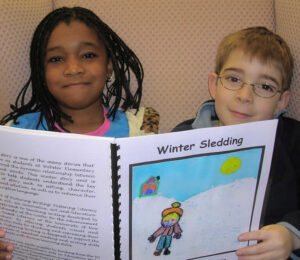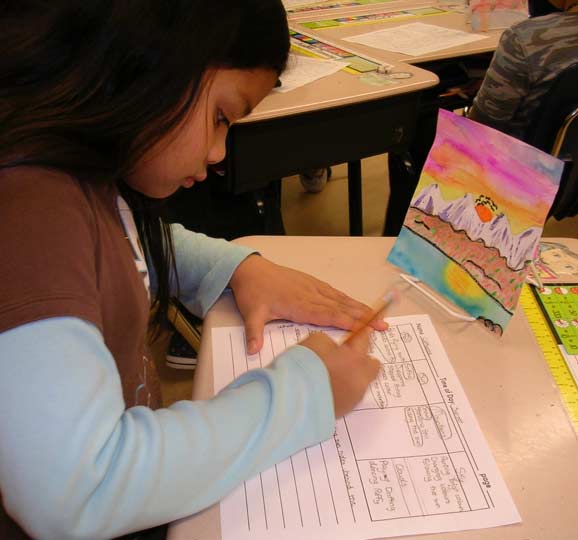These are busy times. The school day is packed with mandated curriculum. Now school districts across the country are adopting new, very time-consuming reading programs. Is there time for Picturing Writing during the school day? For some, perhaps not in your literacy block, but how about during your content area studies?
But why even bother trying to squeeze Picturing Writing into your already crammed-full school day? Maybe you are thinking, “We are already doing some writing tied to our reading program and when there is time, I let my students illustrate their writing. Isn’t that good enough?”
My honest answer is no— that is, not if you want your wide range of learners to all fall in love with writing and become extremely capable, passionate young writers.
What is so different about Picturing Writing anyway?
Within Picturing Writing, students paint first before they write. Then, when it comes time to write, they are looking at their picture to anchor there ideas. You might wonder, “Isn’t that the same as what we have done all along, just reversed?” The answer is that it is not the same; yes, it is reversed; and the outcome is profoundly different.
Watch first- and fifth-graders share their art and writing.
Why paint before you write?
When students create art (ideally aligned with content area studies), they can then learn how to “read their pictures” to access detail and description. Their thinking and their writing becomes much richer as a result. But let’s be clear, the process is not simply an unguided “paint and write.”

Picturing Writing provides multiple layers of scaffolding to ensure that students: 1) create meaningful artwork tied to the curriculum and your writing objectives; 2) read their picture to deepen their understanding of its meaning; 3) brainstorm “silver dollar words and phrases” that describe what is happening in their picture; 4) jot down key words and phrases on a specially designed graphic organizer; 5) read through their word banks to select the very best words to convey their painting’s meaning; and 6) craft sentences that not only capture, but also deepen the meaning of their painting. Students who experience this rich weave between image and text benefit from a phenomenon known as transmediation.
What is transmediation?
Transmediation is defined as the act of recasting or translating meaning from one sign system to another. A sign system is any form of communication: art, writing, mathematics, music, etc. When students create meaning in one sign system and then translate that meaning into another, they experience the phenomenon of transmediation. Transmediation has been shown to: 1) deepen students’ thinking, 2) generate new ideas, and 3) create opportunities for reflective thinking (Siegel, 1995). Within the Picturing Writing process, in which students paint first and then write, transmediaton also fosters vocabulary development which, in turn, results in students having to practice word choice.
Note: If one wanted to play devil’s advocate, one could ask, “Doesn’t writing first and then illustrating one’s writing also create the experience of transmediation (i.e. making meaning in one sign system and then translating that meaning into another)? The answer is: technically, yes. However, if you want your students’ writing to be more detailed and descriptive, it is the “art first” and “reading one’s picture” that ensures that will happen. Writing to a blank piece of paper or a blank computer screen will not improve students’ writing.
Listen to these fifth-grade students explain the power of transmediation in their own words.
Thirty years of data
But you don’t have to believe me or the students. Independent research over the last 30 years has documented student gains in writing, and even reading, compared to those of students participating in more traditional approaches to writing.
Our most recent federally funded research study has documented statistically significant gains in writing when the traditional order of “write and then illustrate” is reversed. The Picturing Writing process has also been shown to improve standardized test scores in writing as well as reading.
Other significant outcomes
Data aside, Picturing Writing (and sister program, Image-Making Within The Writing Process®) have a profound impact on students’ excitement and lived experience of writing in the classroom. Just ask these third graders.
Then listen to first graders share their reflections after completing their Picturing Writing Winter Story Unit.
These social emotional learning outcomes are hard to quantify but are very real in the day-to-day lives of students.

Students are extremely proud of their art and their writing. When they receive their published books, they are highly motivated to practice reading their writing with fluency so that they can share it with their classmates. Students are also excited about performing “the magic trick” for their peers.
What is “the magic trick?”
Once students have created a painting and have written to that picture using the process described above, they are then ready to experience the power of bringing those two sign systems together. I refer to this phenomenon as “simultaneous transmediation,” the processing of words and picture together. In the classroom, it has come to be known simply as “the magic trick.”
To perform the magic trick, a student’s artwork is placed in the “artists frame” at the front of the room. Classmates, typically gathered on the carpet, are instructed to stare at the picture. “Don’t even blink!” I tell the students. (Make sure that the room is quiet so there are no distractions.) From the artists/writers chair, the creator of the work reads his or her writing as classmates stare at the picture in the artists frame. It does not take long before students notice that something magical is happening. The picture appears to “come alive!” Students also report that they “felt like they were there in the picture,” or that “the words made the picture seem real.”
Watch video clip of second grade students experiencing simultaneous transmediation, aka “the magic trick,” for the very first time.
The experience is profound. Indeed, it does feel magical. As you can see, this typically generates quite a bit of excitement in the classroom. And after that, who doesn’t want to learn how to become a magician and make their painting come alive?
But in order to become a magician, students must dissect the magic trick and then learn how to perform it themselves.
Learning how to make magic
Once students have experienced a picture “coming alive,” they all want to try their hand at making magic. In order to do this, they need to learn how to perform the trick. Through a facilitated discussion, teachers can guide students to the discovery that it is actually the strong verbs in a piece of writing, “the action words,” that create the illusion of movement or the picture “coming alive.” It is also the inclusion of sensory description such as mention of a gentle breeze or the sound of crickets chirping that can draw the viewer into the picture. These sensory details, which are often not seen but rather imagined and experienced, help us feel as if we are there in the picture.
Students share their discoveries
Listen to students grades 3-5 from Newmarket, NH to Nunavut talk about what happens when they bring words and pictures together.
Withstanding the test of time
Recently, I reconnected with a teacher whom I trained 29 years ago. She has been doing Picturing Writing and Image-Making in her classroom ever since. She shared, “Over the last three decades, programs have come and gone, but Picturing Writing and Image-Making have withstood the test of time. One thing that I especially love is that all kids can find success with this approach. They are so proud.”
References
Siegel, M. (1995). More than Words: The Generative Power of Transmediation for Learning. Canadian Journal of Education / Revue Canadienne de l’éducation, 20(4), 455–475. https://doi.org/10.2307/1495082
